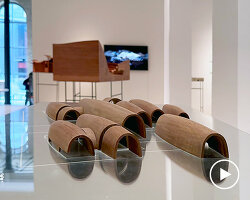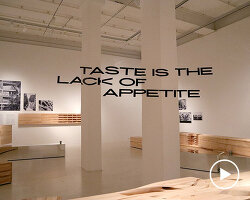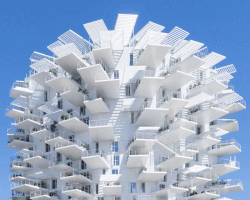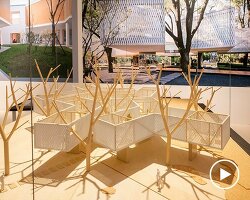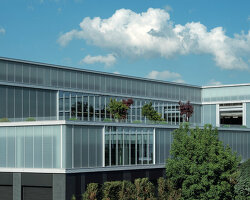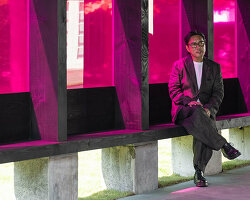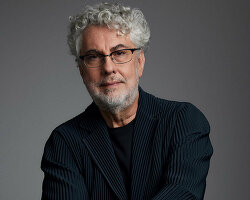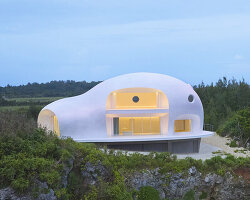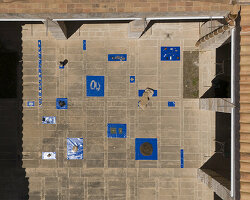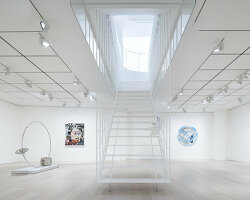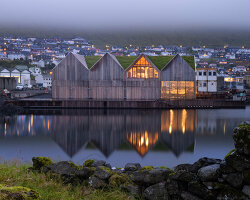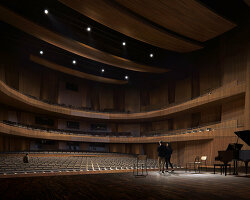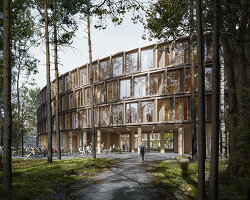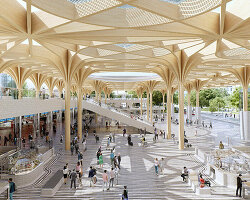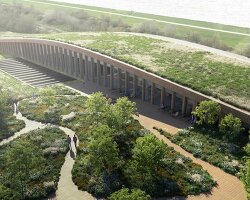Changing our footprint – INTERVIEW with Henning Larsen
Henning Larsen Architects presents ‘Changing Our Footprint’, an explorative solo exhibition at Aedes Architecture Forum in Berlin. Open until March 22, 2023, the show takes us on an inspiring journey introducing small but scalable steps toward a desirable future. Visitors are invited to wander among the studio’s vast scope of projects, discovering its working methods and materials and engaging in a dialogue that seeks to find pioneering ideas to create a buffer against the consequences of climate change.
On the opening day, designboom had the opportunity to sit down with Louis Becker, global design principal at Henning Larsen Architects, to talk about the exhibition as well as the studio’s vision to embrace high-impact solutions for a more sustainable future. According to the architect, the goal is not to provide the final solution but rather a reaction to the current situation. ‘Can urban development tackle past ideas?’, ‘what if architecture and landscape were one?‘, ‘what if the future is built of straw?’ are some of the questions that ‘unroll out of paper’ throughout the venue, giving the audience some food for thought.
The exhibition is divided into ‘Share’ and ‘Explore’, exchanging knowledge and exploring bio-based materials and new tools in the architectural process. The first space seeks to develop new innovative ideas, while the second one celebrates different bio-based materials such as wood, straw, eelgrass, mycelium, reused bricks, low-carbon concrete, and clay, which are explored in examples of selected projects. Topics like transformation, design for disassembly, 3D printing, engineering, acoustics, and indoor climate are demonstrated, while new digital tools are available to interact with. ‘As architects, we should, instead of freezing and stiffening in what we think is the right thing, find the beauty in testing, trying, and being provoked into something,’ Louis Becker tells designboom. Read our interview in full below.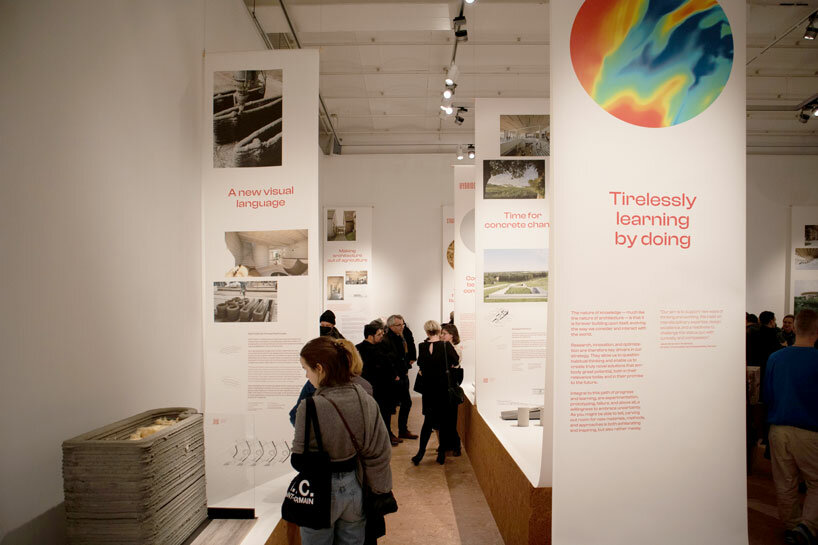
exhibition view of the opening at Aedes | image ©designboom
full header video ©designboom
new expressions of the built environment
designboom(DB): Henning Larsen’s practice is characterized by its sensitive design, producing architectural solutions with a profound respect for the environment and society. How has sustainable design come to be at the heart of the practice, and how has this approach developed throughout the years?
Louis Becker(LB): It started 15 years ago when we were working on different projects in the form of an internal discussion, but also because of the input clients or public authorities provided; it was very primitive at the time. We then decided to engage our first Ph.D. from a technical university with an engineering background. Jakob was the leader of a whole sustainable team, and he came to the studio bringing more scientific tools. With our design skills and his innovative tools, we started developing. Knowing from the beginning that we could not cover everything in this concern, we concentrated on energy consumption, as it was an intensely debated topic, at least in Scandinavia. Specifically, how much energy to use per square meter to light up the building. It took a couple of years, but we quickly learned ways of mitigating and lowering consumption, and from there, we started focusing on the microclimate. Especially in very warm or very cold climates, managing the microclimate and making it work properly becomes a big issue. In Canada, for instance, you can raise the temperature and create a much more pleasant outdoor time, whereas, in the Middle East, it’s about getting the wind through so you have a ventilated place at nighttime that wouldn’t reach 50 degrees, which is the top in the desert in the Middle East.
Next, we moved onto acoustics. We tested the buildings’ noise levels and how the light works. If you visit a Danish kindergarten nowadays, the noises are unbearable. How can you experience these circumstances on a daily basis? We learned that the noise levels are reduced by working with dedicated light — much lower light intensity. We reached the conclusion that when space is lit up differently, our voice naturally drops and goes down. This applies not only to kindergarteners, but also to schools, universities, and workspaces. Finally, we moved on to board materials, which are about carbon emissions. It seems like a never-ending topic because there are so many products and things to try and be sure of. And since there is no common way to do it globally, we have to dive into it specifically. We have people dedicated particularly to this, but we collaborate on the matter together with the universities. For example, we’re working with Columbia University to build the catalog base, but our team also knows the content of the gases and the materials; and that’s also part of the exhibition.
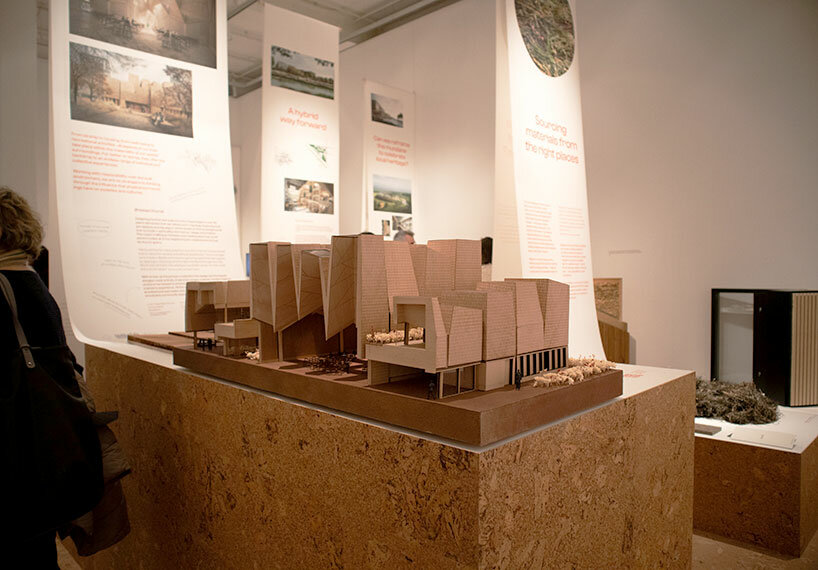
3D model depicting ‘Ørestad Church’ in Copenhagen | image ©designboom
how to avoid material waste and how to build sustainably
DB: Among the displayed projects, could you pick one you consider exemplary of sustainable high-performance design, and why?
LB: We have several projects that are high-performance. It’s interesting the way we conceive aesthetics, here, our notion of beautiful architecture changes a little bit because suddenly, you measure and judge from different perspectives. So one of the most sustainable projects we have in the exhibition is a small extension of a school in an influential part of Denmark. We constructed the whole building in straw and wood and made a mutilation system, as well as applied a clay surface on the walls. But part of this discussion of sustainability is, also, the more multi-faceted approach of construction, different from what you would normally do in traditional architecture. So buildings that might not look really exceptional can be really high performing. Of course, when you try to do architecture, you try to make it interesting and at the same time, sustainable and perform well. But it’s a journey, so in the big exhibition it is just a small piece of paper but then, there is the Volvo brand headquarters Exhibition Center for cars, which is, of course, an enormous project built entirely out of wood. In any case, what needs to be highlighted here is that smaller attempts are steps for us to get to where we need to be.
DB: Before you mentioned ‘beautiful and sustainable.’ Do you think that aesthetics and sustainability can coexist?
LB: Absolutely. I think our notion of beauty in architecture is changing at the moment a lot. For example, my fascination with casted concrete is very different at the moment than what it used to be 10 or 15, or 20 years ago. And so it is changing, of course, it had been changing all the way through in architecture, but at the moment it is changing more rapidly than it would normally. So if you stick to traditional classical architecture, you will get stopped. You somehow have to balance it with the sustainable aspects. And then, at some point, it will be developed itself. But when you see this as beautiful, it’s because you have changed your notion of what is beautiful.
DB: Do you see the traditional role of the architect changing, and how? What are the secrets to a healthier and sustainable future?
LB: I think we have to change to meet the challenges of the world that we’re living in. I don’t know if there are any secrets, but we need to change as the world is changing at a fast pace. If you look at architecture historically, over 500 years, you will see that it also changed because things were changing at the moment; the whole idea of modernism came through technology and an idea of a better world. But technology was the driver, the vehicle that made it happen, to use casted concrete outside and more rational building methods to build cheap, etc. So things are changing, but in my opinion, if we don’t change, we die.
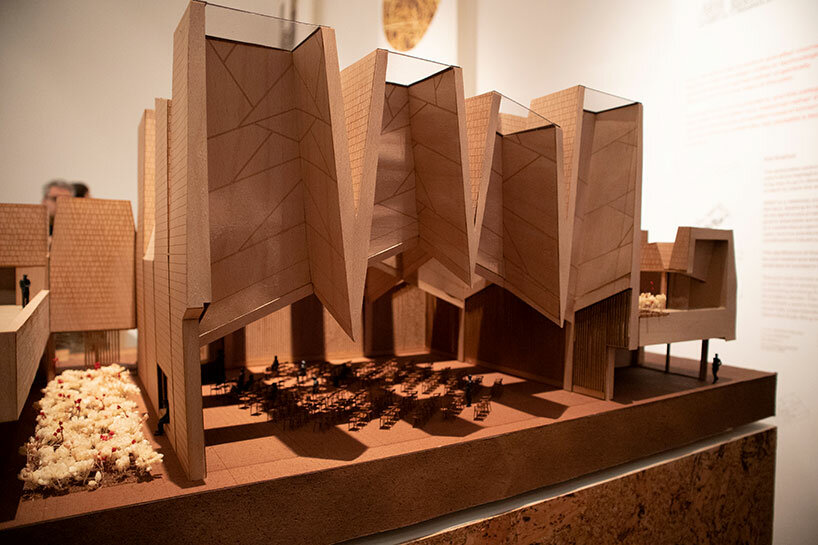
like ‘standing under a canopy of trees’ a striking sculptural roof crowns ‘Ørestad Church’ | image ©designboom
addressing climate change as a challenge rather than a threat
DB: can you tell us what you are working on at the moment?
LB: I’m working on a big project here in Berlin right now. It’s a big urban development in kurfürstendamm. You will see it very soon in the press when it comes out.
DB: what do you hope for your audience to gain from your exhibition?
LB: I hope people, including architects, engineers, people in the building industry, but also private people or public servants, or people in government will see that sustainability in the built environment comes with a lot of small steps. And nobody has a formula that solves it all. Through this exhibition, we will share an open-source idea and we will create a dialogue. Of course, we don’t think we can find all the answers. One of the big things to show in the exhibition is the concrete issue, which is a big substance used in the construction industry throughout the world. It’s pretty naive to think they just say that ‘we will stop all the concrete tomorrow’, it simply won’t happen. It’s the most used substance after drinking water in the world. You can’t just stop it. Also, if you look at developing countries, how would you do anything without concrete or how to build the foundations unless you use advanced methods? So that’s one of the questions we’re trying to ask, who’s best in class at the moment, to come up with solutions for concrete?
We have invited some people from the UK to bring their views on zero-carbon concrete solutions. And then hopefully, it works. It’s still in a bit of a testing phase, but if it works, of course, then we have a decent way of continuing and using it in a much less harmful way than it is today. Even though we have a lot of organic materials and biodiverse, or bio-based materials, it would be super naive to say that the whole world would just use bio-based materials to build. It’s not going to happen for many years to come. So in a way, we have to do this in parallel and have more bio-based solutions to some of the concrete issues. And then, step by step, we’re getting into the workplace. But I also see a lot of opportunities. It’s a whole world, a new field that has brought us to places where we haven’t been before, and I love that this can happen.
So in many ways, I’m not seeing this just as a threat, the whole climate change and what we need to do about it, I also see it as a possibility to act. And I think most architects would hopefully see it like that, instead of a threat, that this is also a way of developing our own skills in new ways. So I really hope that when you see the exhibition, you get this feeling that there are many smaller steps that can be achieved and then there are bigger steps, and you cannot decide 100% on each of them before you are, actually, in that process, so to speak. And again, it’s not something that we can do alone, even though we are a very big practice. We work with universities, we work with smaller studios, we work with big and small engineering companies, etc. It is also rewarding in many ways. As architects, we should, instead of freezing and stiffening in what we think is the right thing, find the beauty in testing, trying, and being provoked into something.
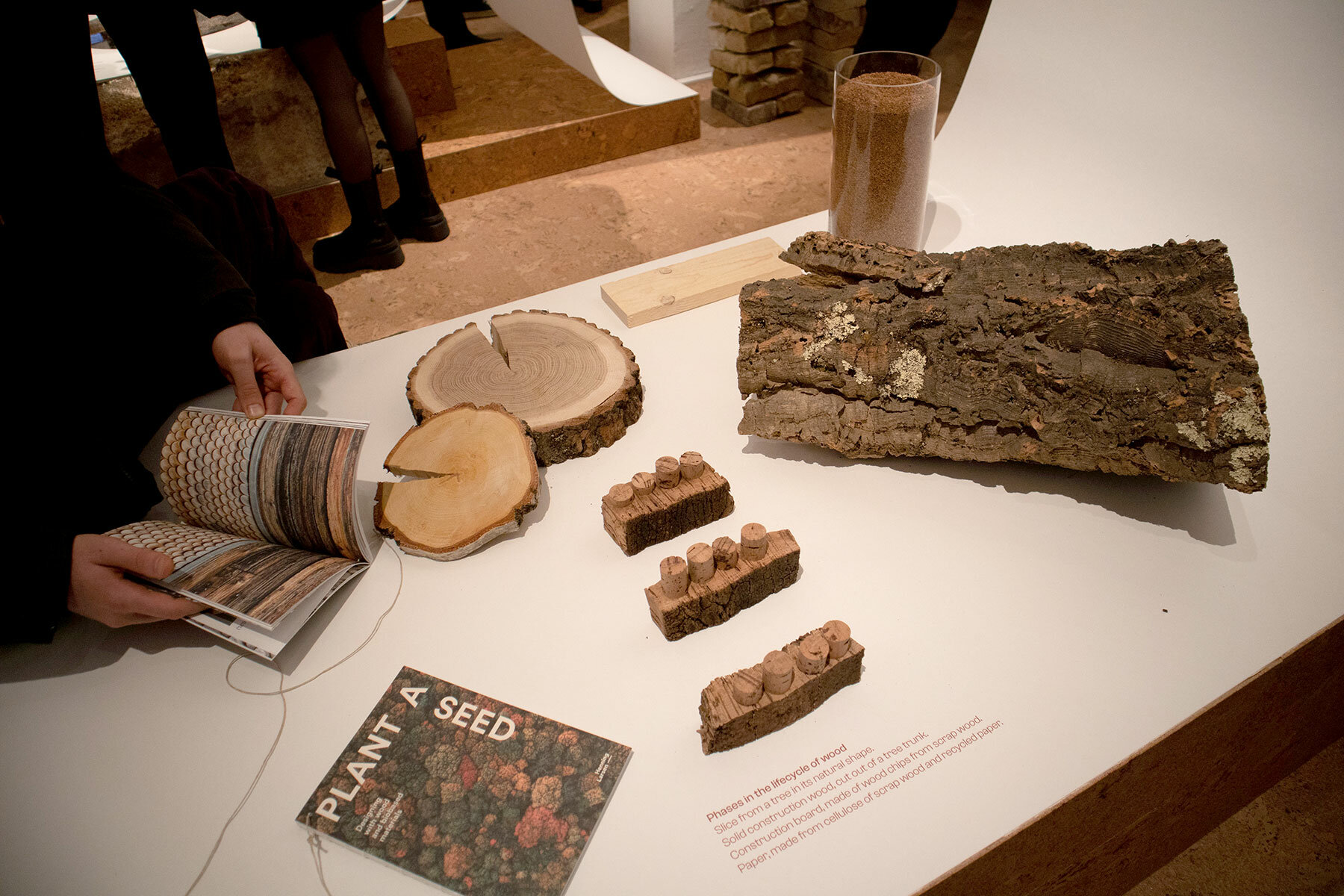
Henning Larsen’s wood and bio-based material publication ‘Plant a Seed’ is on display and can be downloaded for free
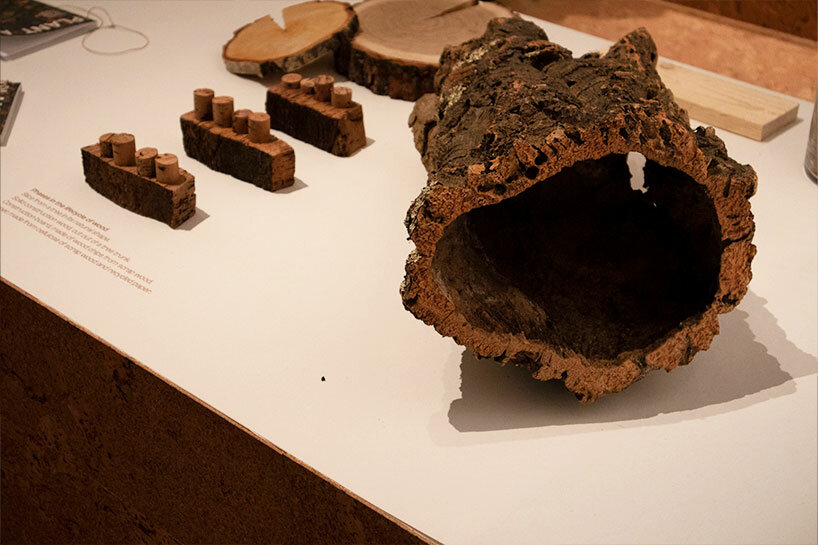
the audience is invited to interact with biobased materials such as wood | image ©designboom
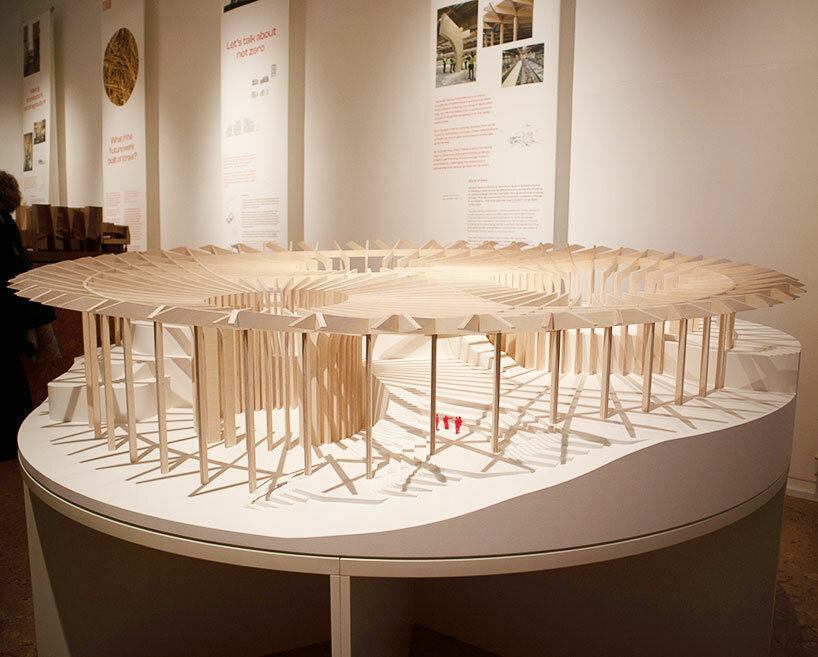
3D model on view: ‘World of Volvo’ in Gothenburg, 2022 | image ©designboom
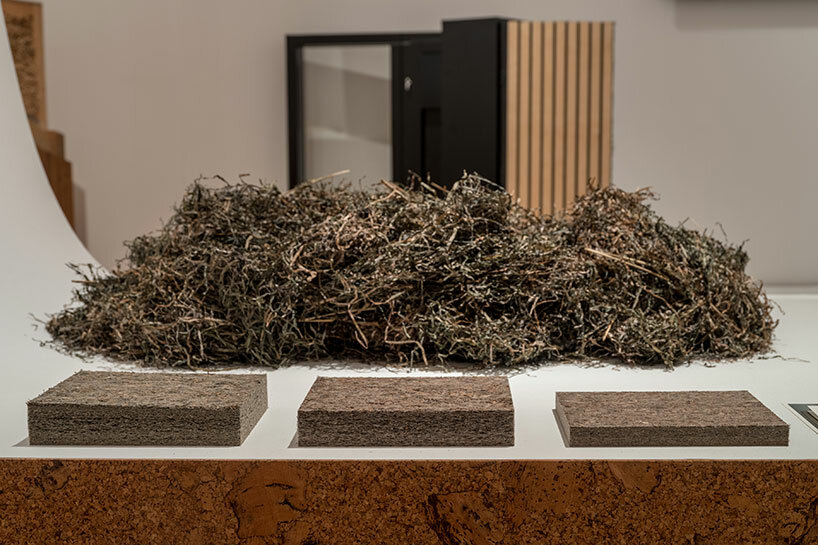
‘Explore’ is dedicated to different bio-based materials such as straw | image © Rasmus Hjortshøj – COAST
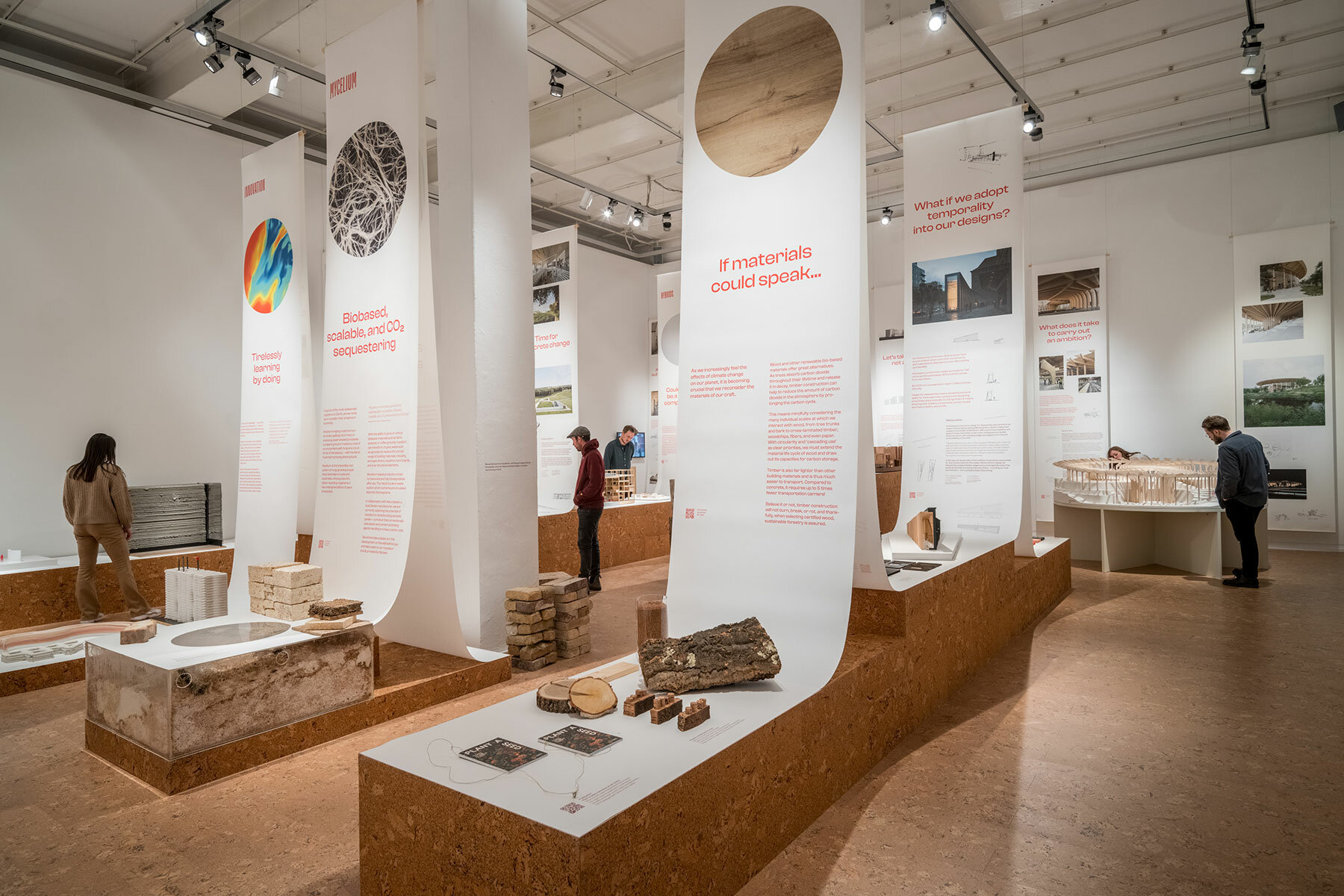
exhibition view, a series of questions spread throughout the space | image © Rasmus Hjortshøj – COAST
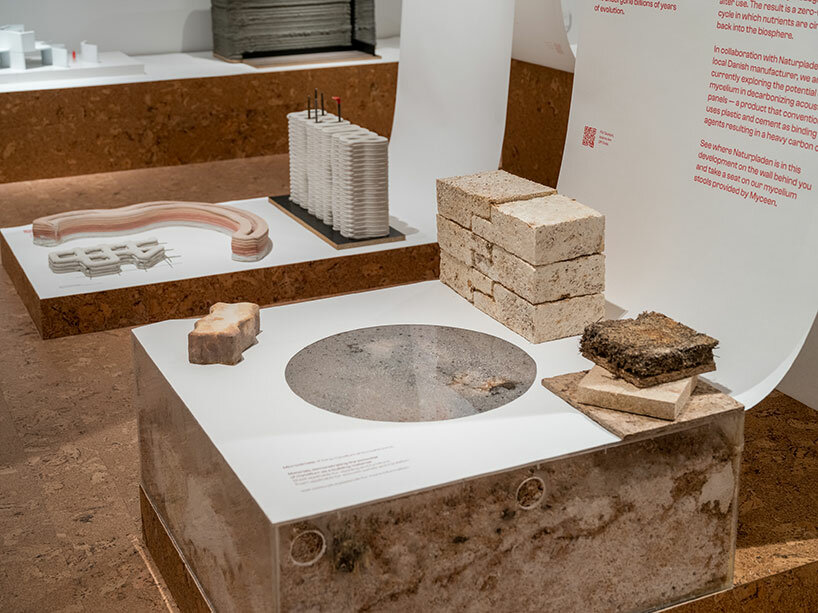
image © Rasmus Hjortshøj – COAST
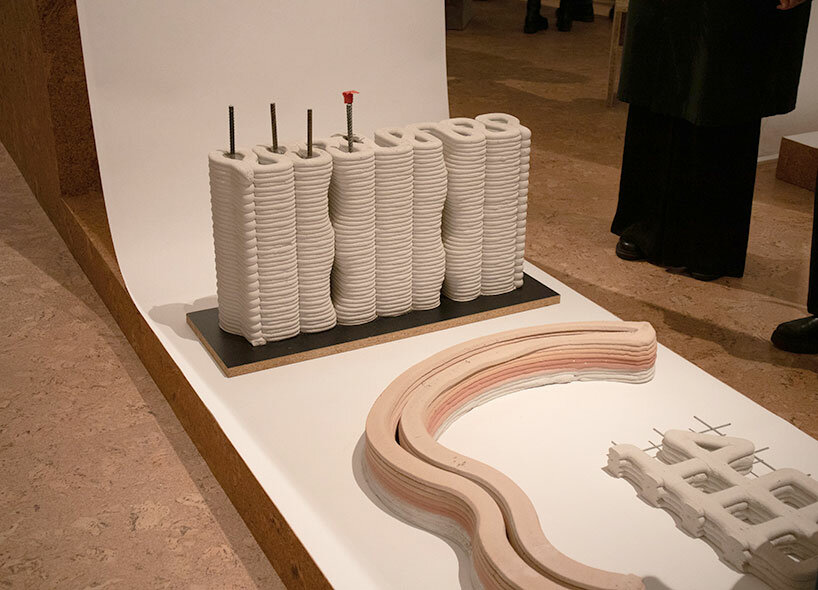
a new visual language | image ©designboom
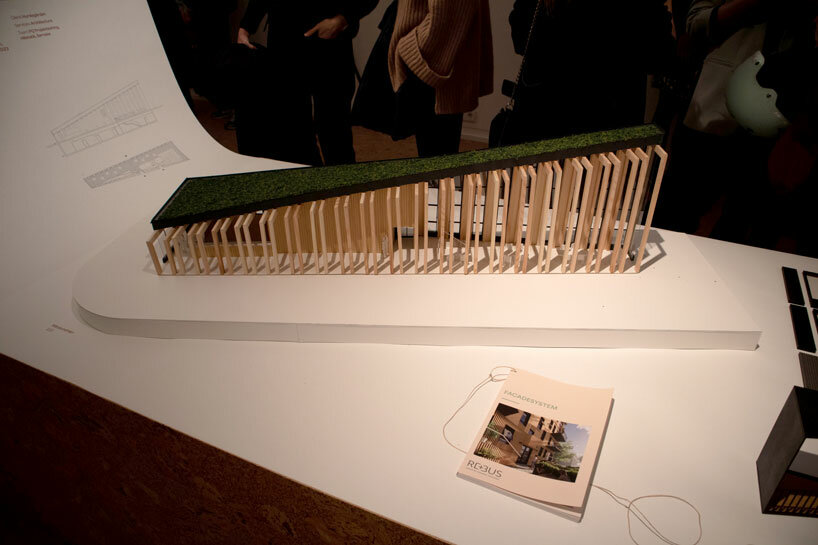
image ©designboom
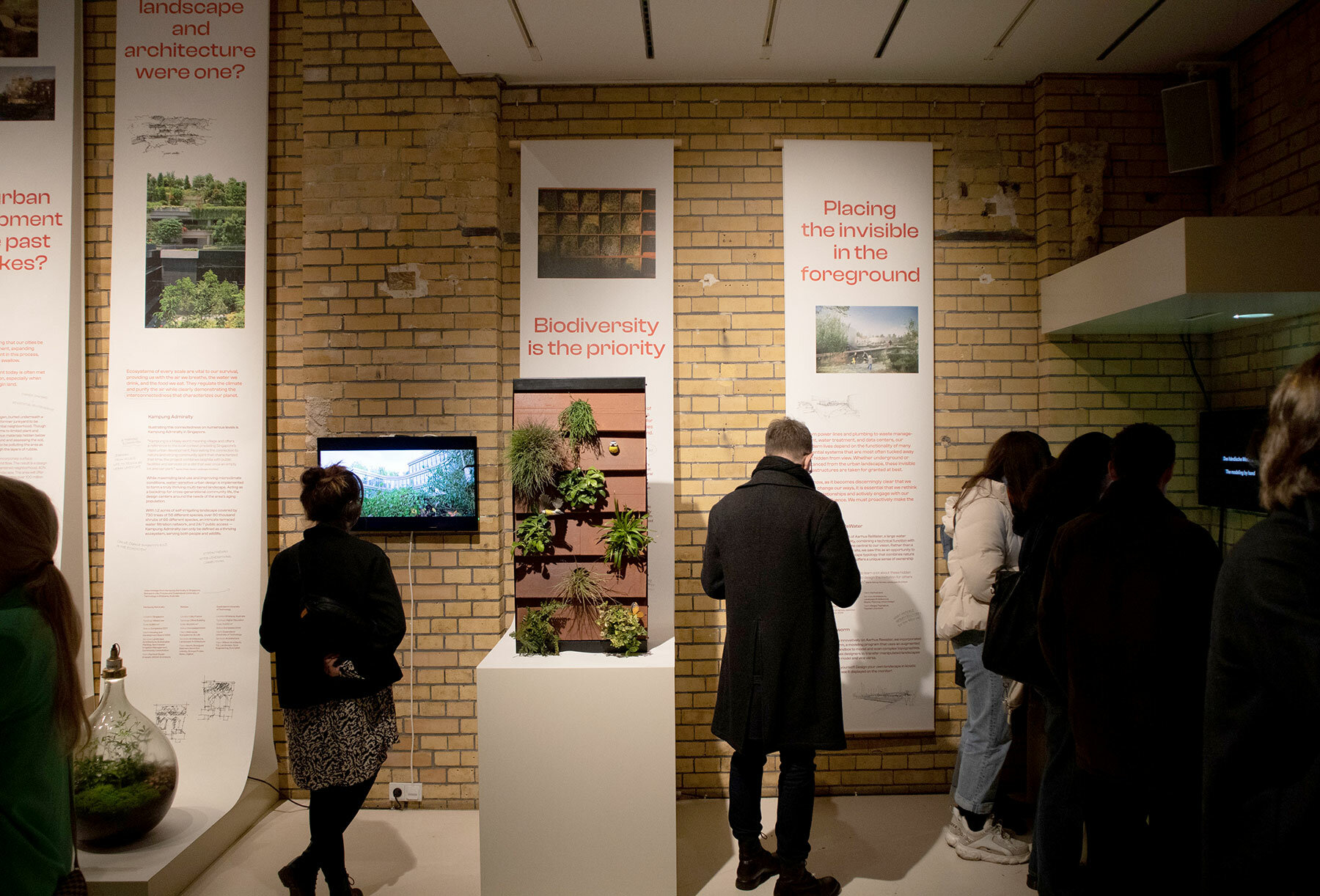
image ©designboom
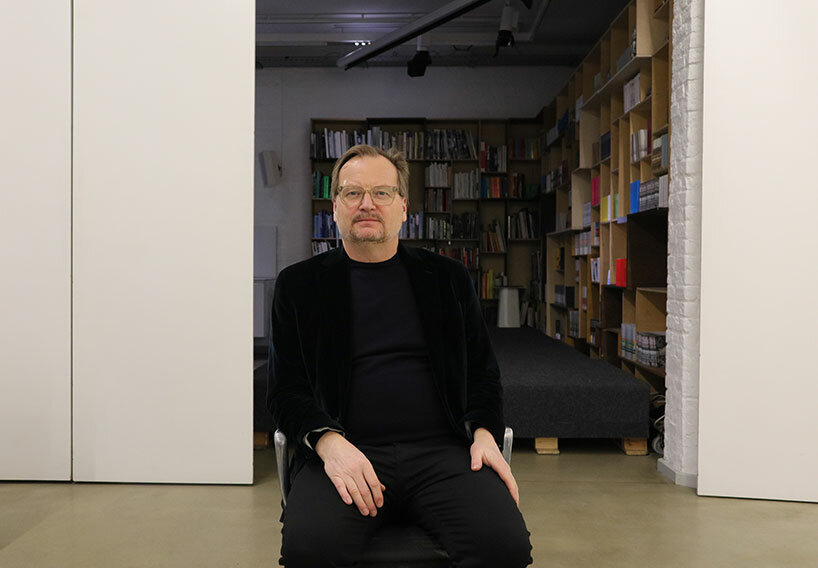

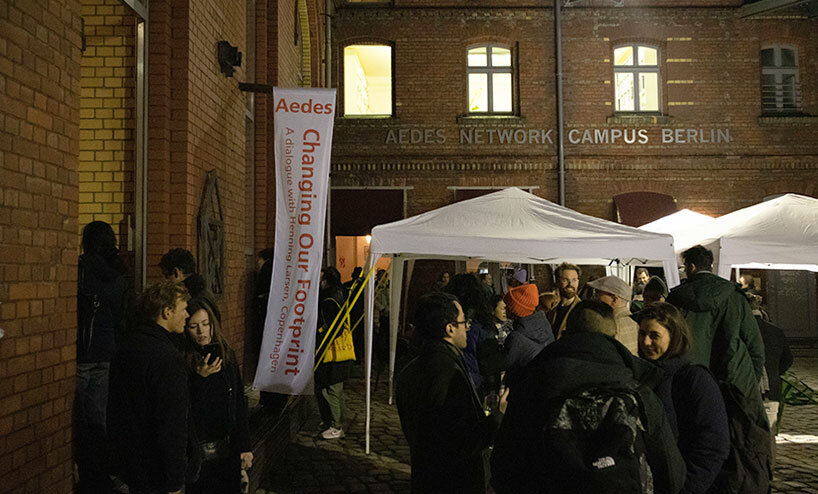



project info:
exhibition name: Changing our footprint | A dialogue with Henning Larsen, Copenhagen
architects: Henning Larsen | @henninglarsenarchitects
venue: Aedes Architecture Forum | @aedesberlin
location: Christinenstraße 18-19, Berlin
dates: 4 Feb to 22 Mar 2023
photography: ©Rasmus Hjortshøj – COAST, ©designboom
videography: ©designboom
aedes architecture forum (22)
architecture interviews (267)
exhibition design (589)
henning larsen architects (60)
PRODUCT LIBRARY
a diverse digital database that acts as a valuable guide in gaining insight and information about a product directly from the manufacturer, and serves as a rich reference point in developing a project or scheme.
